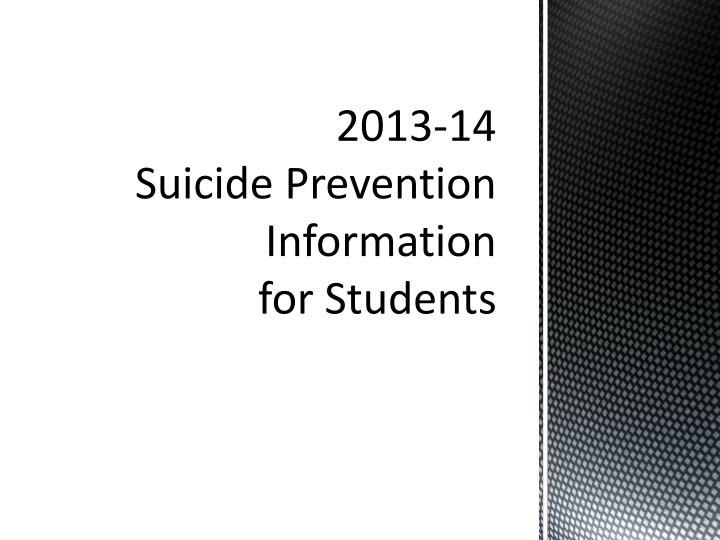
Suicide Prevention Information for Students in the United States
Explore important statistics on suicide, the prevalence in Kentucky, risk factors, warning signs, and the goal of helping students recognize and address mental health concerns to prevent suicide. Discover the importance of receiving suicide prevention information by state law and promoting protective factors in schools.
Download Presentation

Please find below an Image/Link to download the presentation.
The content on the website is provided AS IS for your information and personal use only. It may not be sold, licensed, or shared on other websites without obtaining consent from the author. If you encounter any issues during the download, it is possible that the publisher has removed the file from their server.
You are allowed to download the files provided on this website for personal or commercial use, subject to the condition that they are used lawfully. All files are the property of their respective owners.
The content on the website is provided AS IS for your information and personal use only. It may not be sold, licensed, or shared on other websites without obtaining consent from the author.
E N D
Presentation Transcript
2013-14 Suicide Prevention Information for Students
State law requires that all students in middle and high schools receive some type of suicide prevention information by Sept. 1
In the United States, there were 38,364 deaths by suicide in the year 2010. That s 105.1 suicides each day.
In Kentucky Suicide is the 3rd leading cause of death for 10-14 year olds. Suicide is the 2nd leading cause of death for 15-34 year olds. Suicide is the 4th leading cause of death for 35-54 year olds.
Our Goal: Help students recognize the warning signs and risk factors for their friends and themselves and remind them of the things that serve as a protective factor.
Risk Factors are personal or environmental characteristics that are associated with suicide. People affected by one or more of these risk factors have a greater probability of suicidal behavior. Risk Factors
Risk Factors Risky Behaviors, Social Alienation & Isolation, History of Depression or Anxiety, Low Self Esteem Esteem, Loneliness Loneliness, Self Injury, Previous Suicide Attempts, Loss in Family, Bullying History, Substance Abuse/Dependence Substance Abuse/Dependence, Low Self- - History of Depression or Anxiety
Exposure to other suicides, Limited access to mental health care, Weapons on Campus Weapons on Campus, Exposure to discrimination (based on sexual orientation, race/ethnicity, physical characteristics, etc.),Access to lethal Access to lethal means means, Expression & Acts of Hostility, Negative Social/Emotional Environment
Warning Signs are INDICATIONS that someone may be in danger of suicide either immediately or in the future. Warning Signs
Someone threatens to hurt or kill themselves Someone is looking for ways to kill themselves seeking access to pills, weapons, or other means Someone talking or writing about death, dying, or suicide when this is out of the ordinary for the person Warning Signs
Hopelessness Rage, anger, or seeking revenge Recklessness, acting without thinking Expressions of feeling trapped Increased drug/alcohol use Withdrawal from friends, family, or society Anxiety, agitation, inability to sleep, constant sleep Expresses no reason for living, no sense of purpose in life Giving away personal possessions
Protective Factors These can reduce the probability of suicide. The data suggests that ONE protective factor can help get rid of up to 4 risk factors! =) strong problem solving skills, coping skills, self-esteem, adaptable temperament, emotional intelligence, psychological well being & positive mood, internal locus of control, frequent, vigorous physical activity or participation in sports, spiritual faith / regular church attendance, resilience: ongoing sense of hope in the face of adversity, frustration tolerance and emotional regulation
Social media is one of the most prevalent places for a student to identify he or she is considering suicide. We strongly encourage students to report those comments if they fear for their friend s life. Reporting links have been placed the school guidance page.
National Suicide Prevention Lifeline You are encouraged to store this number in your cell phone (right now if you d like). By calling 1-800-273-TALK (8255) you ll be connected to a skilled, trained counselor at a crisis center in your area, anytime 24/7.
No matter what problems you are dealing with, we want to help you find a reason to keep living. 1-800-273-TALK (8255)
Who Should Call If you feel you are in a crisis, whether or not you are thinking about killing yourself, please call the Lifeline. People have called us for help with substance abuse, economic worries, relationship and family problems, sexual orientation, illness, getting over abuse, depression, mental and physical illness, and even loneliness.
What Happens When I Call? When you dial 1-800-273-TALK (8255), you are calling the crisis center in the Lifeline network closest to your location. After you call, you will hear a message saying you have reached the National Suicide Prevention Lifeline. You will hear hold music while your call is being routed. You will be helped by a skilled, trained crisis worker who will listen to your problems and will tell you about mental health services in your area. Your call is confidential and free.
What Should You Do If A Friend Is In Crisis? Make sure you tell a trusted adult (a teacher, principal, guidance counselor, etc.) that you or a friend are considering suicide as a solution to their problems.
